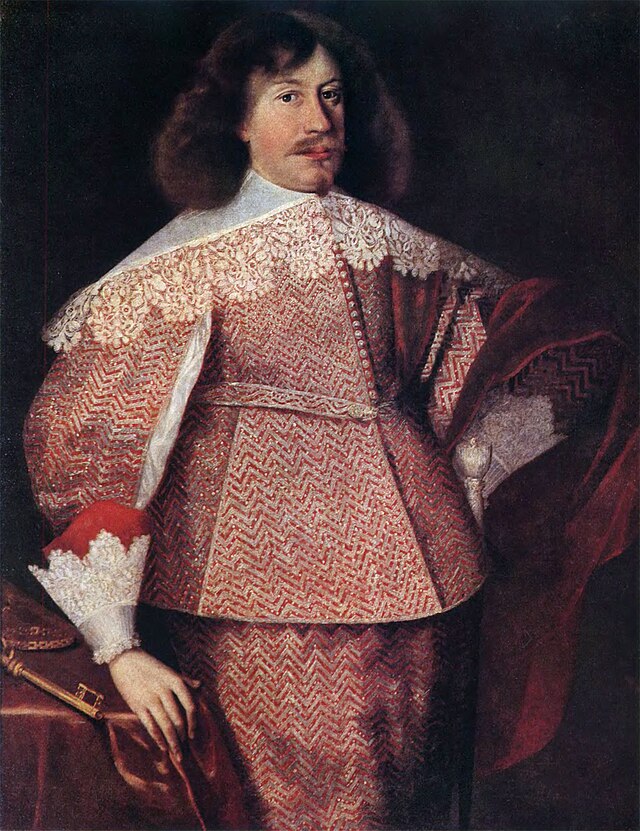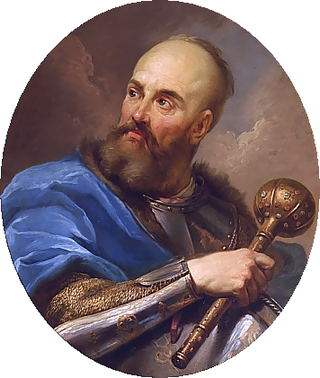Loading AI tools
Historical high-ranking military officers From Wikipedia, the free encyclopedia
Hetmans of the Polish–Lithuanian Commonwealth (Lithuanian: etmonas) were the highest-ranking military officers, second only to the King, in the Polish–Lithuanian Commonwealth. The first Polish title of Grand Crown Hetman was created in 1505. The title of hetman was given to the leader of the Polish Army and until 1581 it was awarded only for a specific campaign or war. Later it became a permanent title, as did all the titles in the Kingdom of Poland and Polish–Lithuanian Commonwealth. It could not be revoked unless treachery had been proven (from 1585). Hetmans were not paid for their services by the Royal Treasury.
This article needs additional citations for verification. (November 2007) |













From the end of 16th century there were two hetmans in the Grand Duchy of Lithuania and two hetmans in the Crown: a Field Hetman and a Great Hetman (sometimes translated as Grand Hetman). As a result, there were in total four hetman titles: Great Crown Hetman, Field Crown Hetman, Great Lithuanian Hetman and Field Lithuanian Hetman. During joint military operations of the Crown and Grand Duchy of Lithuania armies, the Grand Crown Hetman usually was considered superior to others hetmans and served as commander-in-chief if the war actions ran along the borders of the Grand Duchy and vice versa.
Grand Hetmans were usually in command of the professional and mobilised army and during peace stayed at the capital involving themselves in politics, guarding the interests of the army and planning campaigns.
Polish Field Hetman was subordinates of Grand Hetman and when on the same battlefield commanded the mercenaries and artillery. During peace they usually were deployed on the eastern and southern borders of the Commonwealth, and commanded all local forces against constant skirmishes and small invasions of the Ottoman Empire and its vassals. Field Hetman were also called Frontier Hetman, since they did the same job as commanders of frontier garrisons before the title of hetman was introduced.
Lithuanian Field Hetman initially was called Court Hetman and commanded the guard of the Grand Duke, while Land Hetman commanded militia. Later this difference disappeared and they were renamed Field and Great Hetmans accordingly. Contrary to Polish practice Lithuanian Field Hetman had full control on army under his command and wasn't subordinated to the Great Hetman.
For a short period there was also an office of Royal Court Hetman, but it never gained much influence.
Hetman's competences and privileges, first officially described in 1527 in the act of nomination for Jan Tarnowski included:
The hetman had no right to order the forces of the royal court, the royal guard, units equipped by the cities and towns, or private individuals, although during wars those units often voluntarily pledged their obedience to hetmans. Hetmans had no control over the navy, although the Polish Navy was always of very limited importance. Hetmans usually had no direct control over the levy (pospolite ruszenie), but they could give orders to the regimentars who commanded it.
While hetmans were considered to be among the highest-ranking officials in the Polish–Lithuanian Commonwealth, their hetman status gave them no right to sit in either the Senate or Sejm, unless they held another office that automatically carried with it a seat or were elected as a representatives of local szlachta during sejmiks. Each hetman received a hetman's ceremonial mace, the bulawa, as the symbol of his position (it was added to his coat of arms). Less common was a horse-tail ensign and hetman's sign.
In some of the never realised plans of reconstruction of the Polish–Lithuanian Commonwealth from dual into triple state (Polish–Lithuanian–Ruthenian Commonwealth), the hetman was to be a head of the Ruthenian part, consisting of three Ukrainian voivodeships (see Treaty of Hadiach).
The reforms of 1776, stimulated by the first Partition of Poland, limited the powers of the hetmans.
A hetman's chief aides and officers included:
Most of those aides also had a Field/Great and Crown/Lithuanian add-ons to their titles, depending on which hetman they were serving under.
Several new military titles were created after the 1635 by king Władysław IV Vasa, changing some of hetman's responsibilities:
|
| |||||||||||||||||||||||||||||||||||||||||||||||||||||||||||||||||||||||||||||||||||||||||||||||||||||||||||||||
|
| |||||||||||||||||||||||||||||||||||||||||||||||||||||||||||||||||||||||||||||||||||||||||||||||||||||||||||||||||||||||||||||||||||||||||||||||||||||||||||||||||||||||||||||||||||||||||||||||||||||||||||||||||||||||||||||||||||||||||||||||||||||||||||||||||||||||||||||||||||||||||||||||||||||||||||||||||||||||||||||||||||||||||||||||||||||||||||
Seamless Wikipedia browsing. On steroids.
Every time you click a link to Wikipedia, Wiktionary or Wikiquote in your browser's search results, it will show the modern Wikiwand interface.
Wikiwand extension is a five stars, simple, with minimum permission required to keep your browsing private, safe and transparent.